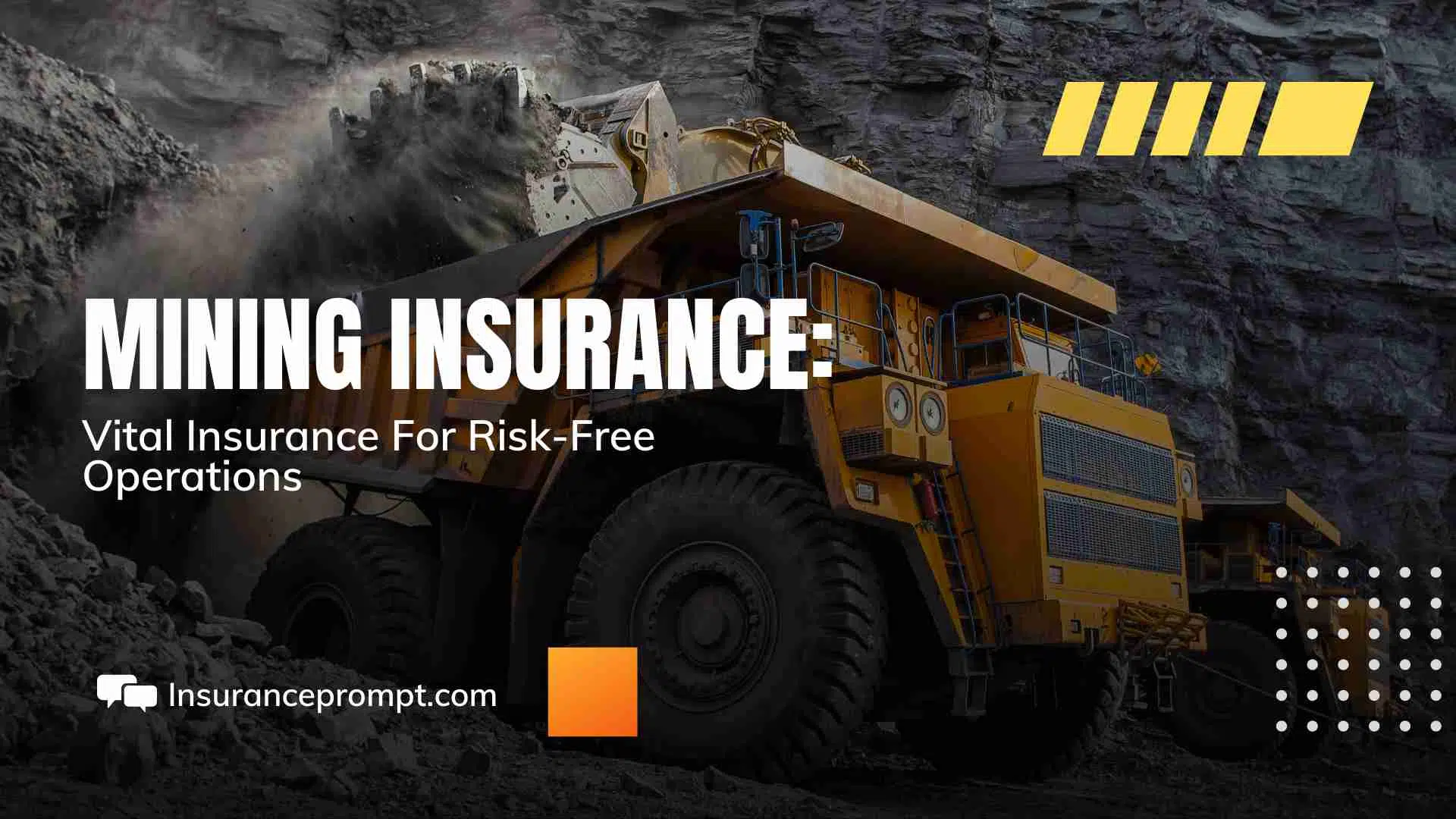Introduction
Welcome to our updated guide on Mining Insurance Solutions, where we prioritize safety above all else in the ever-evolving mining world. As of 2024, the mining industry faces various risks and challenges, making robust insurance coverage a crucial aspect of any mining operation.
Mining activities involve complex processes with inherent risks, including property damage, worker injuries, environmental impacts, and unforeseen accidents. Mining insurance has become essential to safeguard mining ventures and ensure their sustainable growth.
In this comprehensive guide, we will explore the offerings of world-leading providers like Munich Re, Chubb, and others, who have designed specialized insurance products and services tailored to meet the specific needs of the mining industry.
We’ll delve into the expertise of industry experts from companies like Marsh, Gallagher, and Aon, who help mining enterprises, large and small, avoid, manage, and transfer risks throughout the mining lifecycle.
Whether you are a mining company, a contractor, or an investor, this article will equip you with valuable insights on bespoke solutions, risk management, and the key insurance considerations that ensure your mining operations stay safe and secure in 2024 and beyond.
Key Takeaways
- Mining insurance is essential for safeguarding mining ventures and ensuring their sustainable growth.
- Leading insurance providers like Munich Re, Chubb, Marsh, Gallagher, and Aon offer specialized insurance products tailored to the specific needs of the mining industry.
- Mining insurance plays a crucial role in risk management throughout every stage of the product life cycle, covering property damage, business interruption, liability lawsuits, and environmental liability.
- Due to the high-risk nature of their occupation, income protection insurance is critical for miners, providing financial protection in the event of injury or illness that prevents them from working.
- Transportation within the mining industry presents notable risks, such as accidents, equipment damage, theft, and environmental damage, which can be effectively covered through insurance.
- Operational coverages for mining include property, inland marine, general liability, workers’ compensation, cargo and stock throughput, and casualty/liability insurance.
- Mine subsidence insurance offers financial compensation for losses caused by mine subsidence, and its cost varies depending on the state and the desired coverage amount.
- Munich Re is recognized as one of the world’s leading providers of mining insurance, offering customized coverage tailored to mining risks and corporate risk exposure.
- Safety practices and risk management are crucial for minimizing accidents and injuries in the mining industry, and insurance companies like Munich Re have specialized teams with practical knowledge of mining risks.
- The geographical location of a mining operation can influence insurance premiums, as certain areas may be more susceptible to natural disasters or other risks.
- The history of claims and losses has influenced the recognition of insurance as an indispensable financial protection tool in the mining industry.
- Comprehensive mining insurance enables companies to confidently navigate potential challenges and focus on achieving their operational goals.
Table of Contents
What is mining insurance?

Mining insurance, specialized business insurance, offers essential coverage for mining operations. Multiple policies exist to address various risks, encompassing property damage, business interruption, and contractual liability.
Among these policies, mine subsidence insurance stands out as a crucial component. Mine subsidence insurance compensates for losses incurred by the movement of the earth’s surface resulting from underground coal and clay mine collapses. Here are some noteworthy facts about mine subsidence insurance:
- It covers damages to homes caused by land movement triggered by man-made mines.
- This insurance is available in states with active mining operations, such as Pennsylvania.
- It is not typically included in standard homeowners insurance policies and requires a separate purchase.
- Coverage extends to damages caused by mine subsidence, which refers to the sinking or settling of the ground surface due to underground mine collapses.
Understanding the significance of mine subsidence insurance is essential for individuals and communities residing in areas impacted by mining activities.
What is the difference between mining insurance and mine subsidence insurance?
Mining insurance and mine subsidence insurance are distinct yet interconnected insurance policies. Understanding their differences is essential. Let’s explore:
Mining Insurance:
- It is a specialized business insurance tailored for mining operations.
- This coverage encompasses various risks, including property damage, business interruption, and contractual liabilities.
- The primary aim of mining insurance is to protect mining operations from the unique hazards they encounter.
Mine Subsidence Insurance:
- It is a niche insurance policy designed to address residential property damage caused by land movement triggered by man-made mines.
- Available in states with active mining operations, such as Pennsylvania and Ohio.
- The coverage specifically applies to damages from mine subsidence, characterized by the sinking or settling of the ground surface due to underground mine collapses.
- Mine subsidence insurance is not typically included in standard homeowners insurance policies and requires a separate purchase.
In summary, while mining insurance safeguards mining operations from a range of risks, mine subsidence insurance is a specialized homeowners insurance policy that specifically covers damage caused by mine subsidence.
Why is mining insurance vital for risk-free operations?
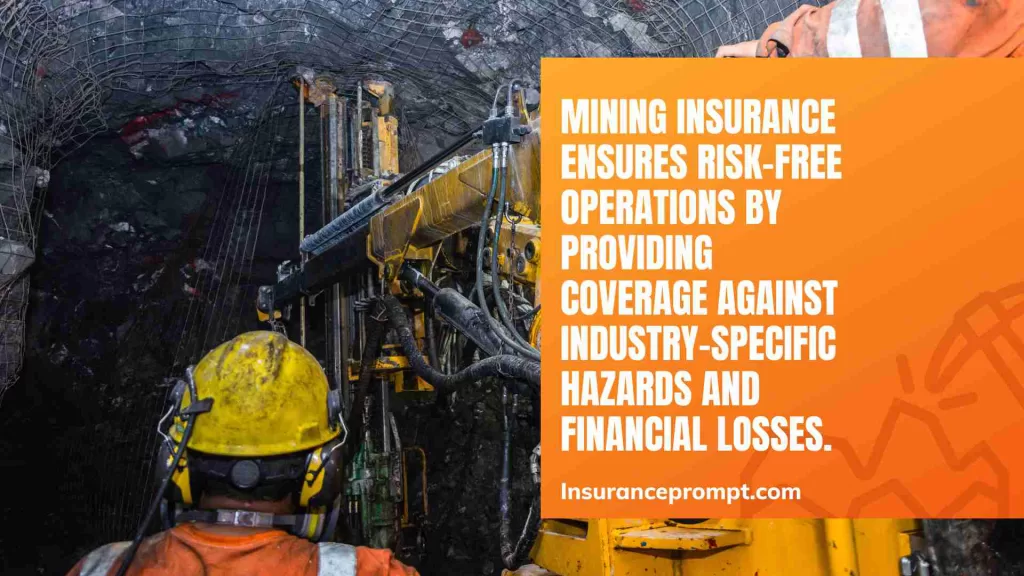
Mining insurance ensures risk-free operations within the mining industry by providing essential coverage for the distinct hazards encountered.
Let’s explore the key reasons mining insurance holds such importance: Protection against liability lawsuits: Mining companies are susceptible to costly liability lawsuits that tarnish their reputation. Mining insurance offers liability coverage, safeguarding against such risks.
Coverage for property damage: Expensive machinery and equipment utilized in mining operations are prone to damage or destruction. Mining insurance provides comprehensive coverage for property damage, encompassing machinery breakdown and protection against natural disasters.
Coverage for business interruption: Various factors, including equipment breakdown, natural disasters, or regulatory issues, can disrupt mining operations. Mining insurance includes coverage for business interruption, aiding companies in recovering lost income and managing necessary expenses.
Compliance with legal requirements: In certain cases, mining insurance becomes a legal requirement. For instance, miners and mining contractors in Australia must possess public liability insurance to meet regulatory obligations.
In summary, mining insurance is an indispensable asset for risk-free operations in the mining industry. It offers coverage against liability lawsuits, property damage, and business interruption and ensures compliance with legal requirements.
By securing appropriate mining insurance, companies can confidently navigate potential challenges and focus on achieving their operational goals.
In what ways does mining insurance assist in risk management throughout every stage of the product life cycle?
Mining insurance plays a crucial role in risk management throughout every stage of the product life cycle, offering coverage tailored to the distinct hazards encountered by mining operations. Let’s explore how mining insurance effectively manages risk at different stages:
Exploration: Mining insurance covers property damage, business interruption, and liability lawsuits during the exploration stage. This coverage assists mining companies in effectively managing risks associated with exploring new mining opportunities.
Development and Construction: During the development and construction stage, mining insurance covers property damage, machinery breakdown, and construction delays. This enables mining companies to navigate risks associated with building and developing new mining operations.
Operation and Expansion: Mining insurance covers property damage, business interruption, and liability lawsuits during the operation and expansion stage. This allows mining companies to effectively manage risks associated with operating and expanding existing mining operations.
Rehabilitation: In the rehabilitation stage, mining insurance covers environmental liability and hazmat cleanup of pollution linked to mining operations. This coverage aids mining companies in managing risks associated with rehabilitating and closing mining operations.
In summary, mining insurance actively manages risk at all product life cycle stages by offering coverage for unique hazards mining operations face.
This includes protection against property damage, business interruption, liability lawsuits, and environmental liability. By securing comprehensive mining insurance, companies can navigate risks effectively and ensure the smooth progression of their mining endeavors.
Types of Mining Insurance Coverage to Manage Risks in the Mining Industry
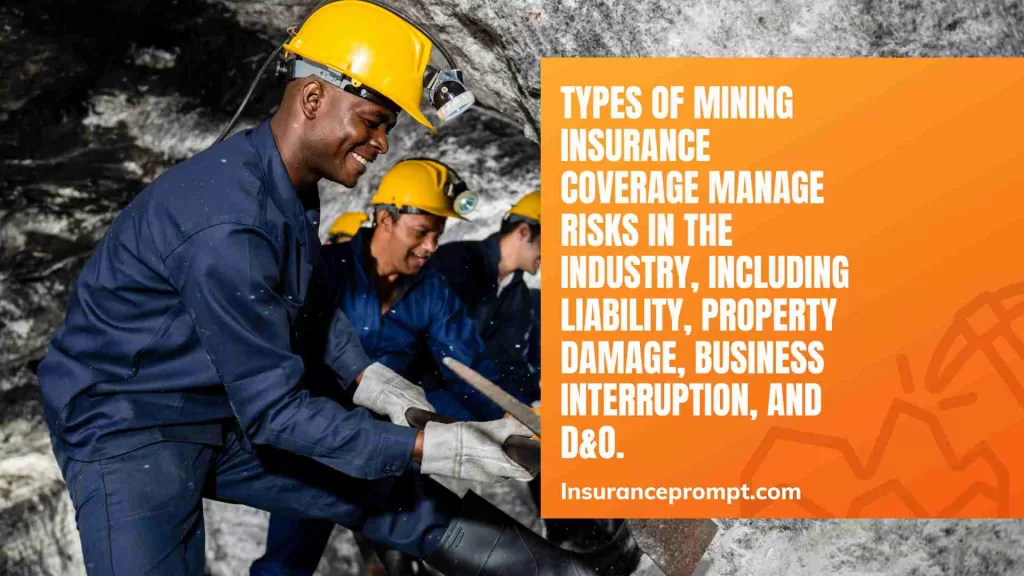
Mining insurance, specialized business insurance, offers essential coverage for the unique hazards encountered in mining operations. Let’s explore various types of mining insurance coverage that effectively manage risks within the mining industry:
Public Liability Insurance: This crucial coverage is paramount for mining contractors, protecting against accidents and injuries on mine sites.
Property Damage Insurance: Mining equipment, machinery, and buildings are susceptible to damage. Property damage insurance offers coverage for such losses.
Business Interruption Insurance: Disruptions in mining operations due to equipment breakdown, natural disasters, or regulatory issues can result in lost income and expenses. Business interruption insurance provides coverage for these financial losses.
Environmental Liability Insurance: Mining operations can have environmental impacts, and this insurance coverage addresses legal defense fees and hazmat cleanup costs associated with pollution resulting from mining activities.
Management Liability Insurance: Directors, managers, and employees may face liability claims, and this insurance covers the costs of defending against such claims, protecting them from personal financial risk.
Transportation and Logistics Insurance: Mining equipment and materials require transportation, and this insurance coverage ensures protection during transit.
In summary, mining insurance encompasses a range of coverage options addressing risks faced by mining operations, including accidents, property damage, business interruption, environmental liability, and transportation risks. By securing suitable insurance coverage, mining companies can effectively manage these risks and operate with confidence.
Here is a table summarizing the types of mining insurance coverage to manage risks in the mining industry:
| Type of Insurance Coverage | Description |
| Public liability insurance | Provides coverage for accidents and injuries on mine sites. |
| Property damage insurance | Provides coverage for damage to mining equipment, machinery, and buildings. |
| Business interruption insurance | It covers the costs of defending directors, managers, and employees against liability claims and shields them from personal financial risk. |
| Environmental liability insurance | Provides coverage for legal defense fees and hazmat cleanup of pollution related to mining operations. |
| Management liability insurance | Covers the costs of defending directors, managers, and employees against liability claims and shields them from personal financial risk. |
| Plant and equipment insurance | Provides coverage for losses arising from breakdown, theft, or damage to essential equipment and machinery. |
| Income protection insurance | Provides coverage for loss of income due to injury or illness. |
| Mine subsidence insurance | Provides coverage for damage to homes caused by a movement of land triggered by a man-made mine. |
Plant and Equipment Insurance: A Valuable Asset for Mining Contractors
Plant and equipment insurance is a specialized insurance coverage that proves highly beneficial for mining contractors. This type of insurance offers protection against losses resulting from equipment breakdown, theft, or damage. Let’s delve into the key advantages of plant and equipment insurance for mining contractors:
Protection against Financial Loss: Plant and equipment insurance covers repairing or replacing damaged or stolen equipment. This safeguard helps mining contractors avoid significant financial losses.
Increased Productivity: With plant and equipment insurance, mining contractors can promptly repair or replace damaged equipment. This enables them to minimize costly downtime and maintain high levels of productivity.
Peace of Mind: Plant and equipment insurance offer mining contractors peace of mind, knowing their valuable equipment is protected against unexpected events like theft or damage. This reassurance allows them to focus on their operations without undue concern.
In summary, plant and equipment insurance is critical for mining contractors as it protects against financial losses, enhances productivity by reducing downtime, and offers peace of mind. This insurance coverage is indispensable for mining contractors who rely on their equipment and machinery to run their businesses effectively.
Income protection insurance
is a vital form of insurance for individuals working in high-risk mining occupations.
Let’s explore the main points regarding income protection insurance for miners:
Types of Cover: Miners can access various types of cover, including Life Insurance, Income Protection, Trauma Insurance, and TPD insurance.
Coverage Limitations: Insurers may offer limited or no coverage for miners due to the nature of their occupation, which presents unique risks.
Monthly Benefit: Income protection insurance ensures miners receive a monthly benefit if they cannot work due to injury or illness, providing financial support during such periods.
Eligibility: Certain professions within the mining industry may be considered ineligible for income protection insurance due to the inherent risks involved.
Coverage Duration: Mining occupations eligible for income protection coverage generally offer benefit durations of 2 years or 5 years.
Flexible Insurance Options: Mine Super provides flexible insurance options tailored for individuals working in mining and related industries. This caters to the challenges of obtaining adequate and reasonably priced insurance in a high-risk occupation.
In summary, income protection insurance is a critical consideration for miners due to the high-risk nature of their occupation.
It provides essential financial protection in the event of injury or illness that prevents them from working. Finding an insurer that offers comprehensive coverage and understands the risks associated with mining is crucial for miners’ peace of mind and financial security.
General Liability Insurance for Mining
General liability insurance is important in mining operations. Let’s delve into the main points regarding general liability insurance for mining:
Specialized Focus: Rockwood, a subsidiary of Argo Group, specializes in offering tailored general liability insurance coverage specifically designed for the coal mining industry.
Specialized Form of Business Insurance: Mining insurance is a distinctive form of business insurance that provides comprehensive coverage for the specific risks that mining operations encounter.
Coverage Types and Options: Mining insurance offers a wide range of coverage types and options to ensure mining operations can adequately protect their business. This includes general liability insurance, among other essential coverage types.
Valuation Challenges: Mining insurance addresses the industry’s current valuation challenges, such as accurately assessing the value of high-value machinery and managing liabilities arising from contractual agreements.
Risk Management: Mining insurance is pivotal in risk management throughout the product life cycle. It encompasses various aspects, including cargo and stock throughput, casualty/liability insurance, and subsidence insurance for coal mines and drilling operations.
Protection Features: National E&S Insurance Brokers Inc. provides coverage options tailored for mining operations. These options include broad protection features specific to the mining industry, such as property coverage, inland marine coverage, general liability coverage, and workers’ compensation coverage.
Generally, general liability insurance is important for mining operations as it covers the unique risks associated with mining activities. It plays a vital role in managing risk throughout the product life cycle.
It is crucial to partner with an insurer that specializes in the mining industry, understands its challenges, and can provide comprehensive coverage tailored to mining operations’ specific needs.
What are the risks associated with transportation in the mining industry, and how can insurance cover them?
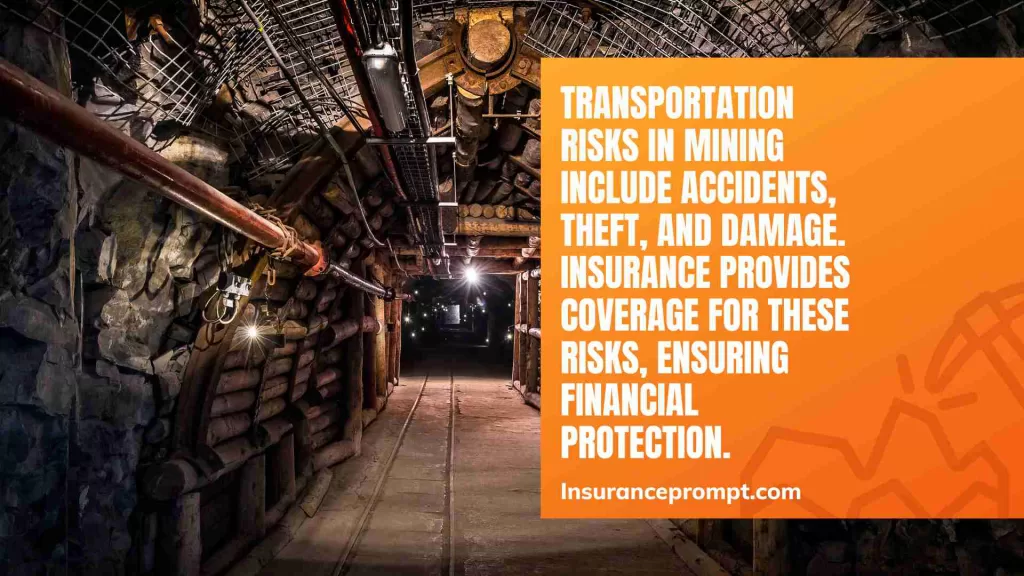
Transportation within the mining industry presents notable risks that insurance can effectively cover. Let’s explore the risks associated with mining industry transportation and the corresponding insurance coverage options:
Risks associated with transportation in the mining industry:
- Accidents and collisions involving mining vehicles and equipment.
- Damage to mining equipment during transportation.
- Theft or loss of mining equipment during transportation.
- Environmental damage caused by spills or leaks during transportation.
Insurance coverage for transportation risks in the mining industry:
- Property damage insurance protects against damage to mining equipment that may occur during transportation.
- Cargo insurance: Cargo insurance safeguards against the loss or damage of mining equipment throughout transportation.
- Environmental liability insurance: Environmental liability insurance addresses legal defense fees and hazmat cleanup costs in case of pollution from transportation accidents.
- Public liability insurance: Public liability insurance provides coverage for accidents and injuries that occur during the transportation of mining equipment.
In summary, transportation within the mining industry entails significant risks that can be effectively managed through insurance coverage.
Mining companies can protect themselves by ensuring appropriate insurance policies, including property damage, cargo, environmental, and public liability insurance. By proactively addressing transportation risks with suitable coverage, mining companies can operate with greater peace of mind.
Operational coverages
play a crucial role in safeguarding mining operations. Let’s explore the main points regarding operational coverages for mining:
Coverage Types and Options: Mining insurance offers a comprehensive array of coverage types and options to ensure mining operations can adequately protect their business. These include property, inland marine, general liability, workers’ compensation, cargo and stock throughput, and casualty/liability insurance.
Liability Coverage: Mining companies face significant risks associated with liability lawsuits. As such, it is vital to include liability coverage as part of a mining business insurance policy. Some key liability coverage types include general, professional, and environmental liability.
Unique Hazards: Mining insurance is specifically designed to address the unique hazards the mining industry encounters. It provides tailored protection against the industry’s distinct risks and challenges.
Flexible Insurance Options: Mine Super offers flexible insurance options for individuals working in mining and supporting industries. These options may include increasing insurance coverage following significant life events.
Risk-Management Services: Gallagher UK provides mining companies with comprehensive insurance solutions and risk management services. This encompasses coverage for natural catastrophes, machinery breakdowns, environmental and transportation hazards, and financial risks.
Mining operations require diverse operational coverages to protect their business against the industry’s hazards and risks. Working with an independent insurance agent or broker is crucial, as they can assess coverage needs and assist in finding competitively-priced policies that align with those requirements.
Coal mining insurance coverage
is specialized mining insurance that protects property owners against losses incurred due to newly discovered problems or adverse entries in subsequent coal mining activities.
The search results indicate that mining insurance offers unique coverage options tailored to the specific needs of mining businesses. Mining companies must assess their coverage requirements and seek competitively-priced policies that align with their needs.
Chubb offers mining insurance products designed to meet the evolving demands of the global market, encompassing property and casualty solutions.
Additionally, Chubb has implemented a policy related to coal underwriting and investment, effective from July 1, 2019. As part of this policy, they no longer underwrite risks associated with constructing and operating new coal-fired plants or new risks for companies generating over 30% of their revenues from thermal coal mining or coal energy production.
AXIS, a reinsurer, has also implemented more stringent climate policies, including the cessation of new insurance for coal plants.
Gallagher provides comprehensive mining insurance and risk-management services, including coverage for property damage, business interruption, directors’ and officers’ (D&O) liability, and construction-related risks.
Insurance Policies for Mining Operations vs. Other Types of Business Insurance
Mining insurance policies differ from other types of business insurance in several key ways.
Specialized focus: Mining insurance is designed to address the unique hazards mining operations face, making it a specialized business insurance.
Coverage types and options: Mining insurance provides a comprehensive range of coverage types and options that cater to the specific needs of mining operations. This includes coverage for property, inland marine, general liability, workers’ compensation, cargo and stock throughput, and casualty/liability insurance.
Liability coverage: Due to the significant risk of liability lawsuits in the mining industry, mining insurance policies prioritize liability coverage. This includes coverage for general, professional, and environmental liability.
Eligibility review: Each mining insurance policy undergoes an individual eligibility review to ensure it aligns with the unique requirements and risks associated with mining operations.
Inspections: Inspections of mining risks are typically required before binding coverage to ensure compliance with insurance standards and mitigate potential risks.
In summary, mining insurance policies offer specialized coverage that specifically caters to the distinctive needs and hazards mining operations face. They encompass various coverage options, prioritize liability protection, undergo eligibility reviews, and often require inspections.
Collaborating with an independent insurance agent or broker who understands the intricacies of mining insurance is crucial to identifying the right coverage that meets the specific needs of mining operations.
Mine Subsidence Insurance Coverage
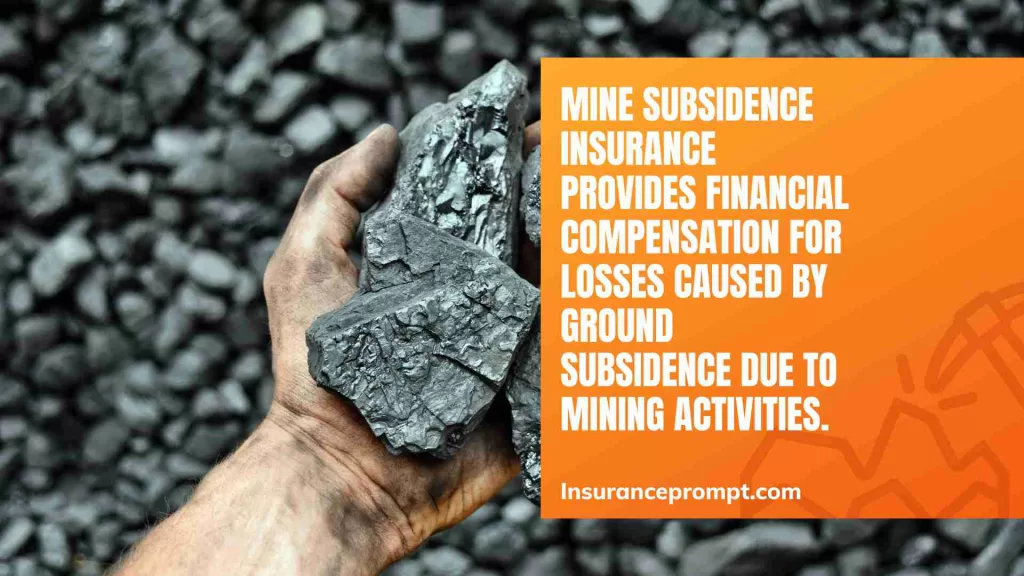
Mine subsidence insurance coverage is a distinct form of insurance that offers protection against damages caused by the sinking of a man-made mine. Here are the main ideas from the search results:
Standard homeowners insurance policy: A standard homeowners insurance policy does not typically cover damages resulting from mine subsidence.
Specialized coverage: Mine subsidence insurance is a specialized type of homeowners insurance policy designed to safeguard your finances in case of structural damage caused by mine subsidence.
Coverage limits: The limits of mine subsidence coverage may vary depending on the state of residence and the insurance companies issuing the policy.
Generally, the policy includes a deductible but offers coverage up to a specific limit, as stated in the policy.
Coverage availability: Mine subsidence coverage is available in certain states, such as Pennsylvania and Indiana, through a non-profit Mine Subsidence Insurance fund. Licensed insurance agents can provide options for purchasing this additional policy in other states.
Coverage amount: In Pennsylvania, mine subsidence coverage can be obtained from $5,000 to $1,000,000. For example, coverage of up to $750,000 can be purchased in Illinois.
Deductible: The deductible for subsidence insurance typically amounts to two percent of the coverage amount.
In summary, mine subsidence insurance coverage is a specialized insurance type that offers financial protection against damages caused by the sinking of man-made mines.
It is important to consult with a licensed insurance agent or the Mine Subsidence Insurance fund in your state to determine the availability of this coverage, as well as the coverage limits and deductibles applicable.
What is the cost of mine subsidence insurance?
The cost of mine subsidence insurance coverage can vary based on the state of residence and the insurance company issuing the policy. Here are the main ideas from the search results:
Coverage limits: Mine subsidence coverage ranges from $5,000 to $1,000,000 in Pennsylvania. In Illinois, for instance, coverage can be purchased up to $750,000.
Premiums: The cost of mine subsidence insurance coverage varies depending on the state and the insurance company. In Pennsylvania, a residential coverage of $150,000 costs approximately $41.25 per year. Ohio’s annual premium is $1 in mandatory and $5 in optional counties.
Deductible: The deductible for subsidence insurance is typically two percent of the coverage amount, with a minimum deductible of $250 and a maximum of $500.
In summary, the cost of mine subsidence insurance coverage is influenced by factors such as the state of residence and the specific insurance company. Coverage limits can vary between states, and premiums are determined based on various factors.
The deductible for subsidence insurance follows a typical structure, with a percentage of the coverage amount set as the deductible, subject to minimum and maximum limits.
Customized Insurance Coverage for Your Mining Operation
Customized insurance coverage is essential for mining operations to adequately protect themselves from the specific risks and hazards they face. Here are some key points regarding mining insurance:
- Specialized focus: Mining insurance is a unique business insurance designed to address the specific hazards encountered in mining operations.
- Coverage types and options: Mining insurance offers a comprehensive range of coverage types and options tailored to the needs of mining businesses. This includes coverage for property, inland marine, general liability, workers’ compensation, cargo, stock throughput, and casualty/liability insurance.
- Liability coverage: Mining companies face significant risks of liability lawsuits. Therefore, it is crucial to include liability coverage in a mining business insurance policy. Various types of liability coverage, such as general, professional, and environmental, should be considered.
- Customized coverage: Insurance brokers and agents work closely with mining operations to customize insurance coverage that aligns with their needs and risks.
- Inspections: Before binding coverage, inspections of all mining risks are necessary to ensure appropriate coverage.
In summary, mining operations should seek customized insurance coverage to adequately protect their business from the unique hazards and risks associated with the industry. Collaborating with an independent insurance agent or broker is recommended, as they can evaluate coverage requirements and assist in finding competitively-priced policies that fulfill those needs.
Benefits of Mining risk coverage for the Mining Industry

Mining insurance is a specialized form of business insurance that caters to the unique risks and hazards in the mining industry. Here are the key benefits of mining insurance:
- Comprehensive risk coverage: Mining insurance offers coverage for a wide range of risks, including crime/financial fidelity, cyber threats, directors & officers liability, employment practices liability, errors & omissions, crisis management, business interruption valuation/extra expense, subsidence identification, property risk assessments, flood exposure review, and critical equipment breakdown.
- Protection for mining operations: Specifically designed for mining operations, this insurance provides essential protection against the distinct hazards encountered in the mining industry.
- Financial compensation for losses: Mine subsidence insurance provides financial compensation in cases where losses occur due to the movement of the earth’s surface resulting from the collapse of underground mines.
- Customized coverage: Munich Re offers tailored insurance coverage for mining risks, allowing customization to meet the unique needs of each mining operation.
In conclusion, mining insurance offers coverage for diverse risks, safeguards mining operations, provides financial compensation for losses, and can be personalized to suit the specific requirements of individual mining operations.
Protection against financial losses
Mining insurance safeguards against financial losses mining companies encounter. Here are the main ways mining insurance can provide protection:
- Coverage for liability lawsuits: Liability lawsuits pose a substantial financial risk for mining companies. Mining insurance policies cover legal defense fees and damages from liability lawsuits.
- Coverage for environmental damage: Mining operations can cause environmental damage that necessitates costly cleanup. Mining insurance policies can include coverage for the hazmat cleanup of pollution associated with mining activities.
- Protection for mining operations: Mining insurance protects mining operations from their unique hazards. This can encompass coverage for property damage, business interruption, and protection against natural catastrophes such as floods, earthquakes, or storms.
- Coverage for crime and cyber risks: Mining insurance policies extend coverage for crime/financial fidelity and cyber risks, which have the potential to result in significant financial losses for mining companies.
To sum up, mining insurance protects against financial losses by offering coverage for liability lawsuits, environmental damage, natural catastrophes, crime, and cyber risks.
Legal compliance and risk mitigation
Legal compliance and risk mitigation are crucial considerations for the mining industry. Mining insurance plays a vital role in addressing these concerns through various means:
- Coverage for liability lawsuits: Mining companies face the potential legal risk of liability lawsuits. Mining insurance policies cover legal defense fees and damages arising from such lawsuits.
- Coverage for environmental damage: Mining operations can cause environmental damage, leading to legal liabilities. Mining insurance policies cover hazmat cleanup related to pollution resulting from mining activities.
- Customized risk solutions: Munich Re offers tailored risk solutions designed to meet the specific needs of each mining operation. This facilitates proactive risk identification and mitigation for mining companies.
- Coverage for crime and cyber risks: Mining insurance policies extend coverage for crime/financial fidelity and cyber risks, which pose significant legal and financial risks for mining companies.
- Expertise in risk management: Aon provides risk management programs tailored to the mining industry. This expertise aids mining companies in proactively identifying and mitigating risks.
In conclusion, mining insurance assists in legal compliance and risk mitigation by offering coverage for liability lawsuits and environmental damage, providing customized risk solutions, covering crime and cyber risks, and offering expertise in risk management.
Peace of mind for mining operators
Mining insurance brings peace of mind to mining operators through the following advantages:
- Specialized coverage: Mining insurance is designed to address the unique risks and hazards the mining industry faces. It offers comprehensive coverage options tailored to the specific needs of mining companies, ensuring proper protection for their operations.
- Customized risk solutions: Munich Re provides tailored risk solutions that cater to the specific requirements of each mining operation. This proactive approach assists mining companies in identifying and mitigating risks, leading to peace of mind for mining operators.
- Expertise in risk management: Aon delivers risk management programs tailored to the mining industry. Their expertise helps mining companies proactively identify and mitigate risks, reducing the overall cost of risk and ensuring compliance with regulatory requirements.
- Coverage for various risks: Mining insurance covers many risks, including liability lawsuits, environmental damage, crime/financial fidelity, cyber risks, property damage, business interruption, and natural catastrophes like floods, earthquakes, or storms. This comprehensive coverage minimizes potential financial losses and offers reassurance to mining operators.
In summary, mining insurance offers specialized coverage, customized risk solutions, expertise in risk management, and coverage for various risks. These benefits collectively provide peace of mind for mining operators, ensuring their operations are adequately protected.
Improved business practices
Mining insurance enhances business practices within the mining industry through the following means:
- Increased awareness of risk management: The growing knowledge and awareness of risk management and corporate governance have led to a shift in insurance purchasing. Insurance is now recognized as an essential tool for effectively managing risks in the mining industry.
- Improved coverage options: Mining insurance offers coverage options specifically tailored to the unique needs of the mining industry. This enables mining companies to obtain appropriate insurance coverage and effectively manage risks.
- Specialized risk management: Mining insurance is a specialized business insurance designed to address the mining industry’s risks and hazards. By providing coverage for these specific risks, mining insurance aids mining companies in proactively identifying and mitigating risks, thereby improving their overall risk management practices.
- Adaptation to changing market requirements: as an insurance provider, Chubb maintains expertise by adapting insurance products to meet the evolving market demands worldwide. This adaptability helps mining companies stay updated with changing market requirements and improve their business practices accordingly.
In summary, mining insurance improves business practices in the mining industry by fostering awareness of risk management, offering improved coverage options, providing specialized risk management solutions, and adjusting to changing market requirements.
Factors Affecting Insurance Premiums
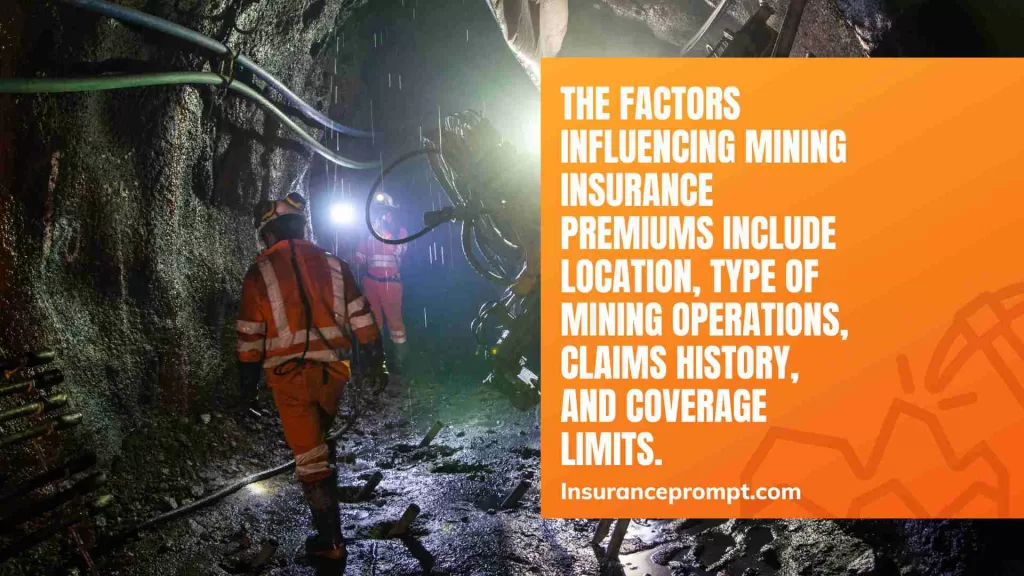
Factors influencing mining insurance premiums encompass the following:
- Type of Coverage: The specific coverage needs of mining companies play a role in determining premium costs. For instance, liability and environmental liability coverage tend to be more expensive due to the elevated risk of liability lawsuits and environmental damage in the mining industry.
- Risk assessment: Insurance premiums are based on the likelihood of potential claims. The higher perceived risk may result in higher premiums. Insurers may conduct risk assessments to evaluate the risk associated with a mining operation, which can impact premium costs.
- Loss history: A mining company’s past loss history is considered when determining premiums. If a mining company has a track record of significant losses, the cost of premiums may be higher.
- Nature of the business: The mining business can influence premium costs. Mining companies that employ heavy machinery or work with explosives may face higher premiums due to the increased risk of property damage and accidents.
- Market conditions: The insurance market for mining companies can be influenced by various market conditions, such as natural disasters or economic downturns. For instance, mining companies affected by natural disasters may encounter higher premiums due to the heightened risk of property damage and business interruption.
In summary, factors affecting mining insurance premiums include the type of coverage required, risk assessment, loss history, nature of the business, and market conditions. These factors collectively contribute to determining the cost of premiums for mining insurance.
How can mining companies reduce their insurance premiums while maintaining adequate coverage?
Mining companies can effectively reduce their insurance premiums while maintaining adequate coverage through the following strategies:
- Risk management: Implementing robust programs enables mining companies to lower insurance premiums. This involves conducting comprehensive risk assessments, implementing safety protocols, and investing in employee training to minimize accidents and losses.
- Proper coverage: Collaborating with independent insurance agents allows mining companies to assess their coverage needs accurately. Mining companies can ensure adequate coverage without paying for unnecessary features by finding competitively-priced policies that precisely meet those requirements.
- Loss prevention: Taking proactive measures to prevent losses is crucial. Mining companies can invest in maintenance and safety equipment, implement rigorous safety protocols, and conduct regular inspections. These efforts decrease the likelihood of losses, resulting in lower insurance premiums.
- Market research: Conducting thorough research on the insurance market allows mining companies to identify the most competitive rates and coverage options. Working with insurance brokers or agents specialized in the mining industry helps find the most favorable terms.
- Compliance: Ensuring compliance with all relevant regulations and standards is essential for reducing the likelihood of legal claims. By adhering to these requirements, mining companies can minimize risks and lower insurance premiums.
In summary, mining companies can effectively reduce insurance premiums while maintaining adequate coverage by implementing risk management practices, obtaining proper coverage, focusing on loss prevention, conducting market research, and ensuring compliance with regulations and standards.
Type of mining operation
The type of mining operation plays a significant role in determining mining insurance premiums, considering the following factors:
- Liability lawsuits: Mining companies risk liability lawsuits, making various liability coverage options essential within their insurance policies. These coverages protect legal defense fees and hazmat cleanup costs associated with mining-related pollution.
- Environmental damage: Mining operations can result in environmental damage, requiring pollution and environmental liability coverage. This coverage safeguards against legal expenses and facilitates hazmat cleanup related to environmental incidents caused by mining activities.
- Reduced output: Reduced output in the mining industry has been known to cause price spikes in global commodity costs. These circumstances may present coverage challenges within insurance policies and should be considered when determining suitable coverage.
- Type of mining risk: Munich Re offers tailored insurance solutions for all mining risks, encompassing property and liability coverage. Their customized risk solutions address the specific needs of mining and mineral processing operations, including various commodities, open-pit and underground mining, alluvial mining, transportation, equipment, and processing plants.
- Mine subsidence: Mine subsidence insurance policies cover damages from the ground surface movement caused by mining activities. Programs such as the Indiana Mine Subsidence Program protect homeowners and property owners in affected areas, particularly southwestern Indiana along the Illinois Coal Basin.
- Captive-related structure: An appropriate captive-related structure can significantly impact the cost and availability of suitable insurance for large mining groups. Exploring the right captive-related structures can help optimize insurance solutions for mining operations.
It’s important to note that these factors are not exhaustive, and other variables may influence mining insurance premiums. Consulting with an insurance professional is recommended to assess the specific factors relevant to your mining operation and their potential impact on insurance premiums.
Location and environment
The location and environment of a mining operation have significant implications for mining insurance premiums, considering the following factors:
1. Natural catastrophes: The mining industry is exposed to natural catastrophes like floods, earthquakes, and storms, heightening the risk of property damage and business interruption. Munich Re offers insurance coverage to protect against natural catastrophes, among other risks.
2. Environmental damage: Mining operations can result in environmental damage, necessitating pollution, and environmental liability coverage. These coverage options provide financial protection for legal defense fees and hazmat cleanup related to mining-related pollution incidents.
3. Reduced output: Reduced output in the mining industry has been known to cause price spikes in global commodity costs. Such circumstances may present coverage considerations within insurance policies, requiring appropriate coverage to address potential financial impacts.
4. Mine subsidence: Mine subsidence insurance policies cover damages from the ground surface movement caused by mining activities. Programs like the Indiana Mine Subsidence Program safeguard homeowners and property owners in affected counties, particularly southwestern Indiana along the Illinois Coal Basin.
5. Location: The geographical location of a mining operation can also influence insurance premiums, as certain areas may be more susceptible to natural disasters or other risks. This geographical risk assessment plays a role in determining the cost of insurance coverage.
It’s important to note that these factors are not exhaustive, and other variables may impact mining insurance premiums. Consulting with an insurance professional is recommended to assess the specific factors relevant to the location and environment of your mining operation and their potential impact on insurance premiums.
History of claims and losses
The evolution of insurance purchasing in the mining industry has been influenced by its history of claims and losses, leading to the recognition of insurance as an indispensable financial protection tool. The sector has faced unprecedented losses in recent years, resulting in over $5 billion in property damage and business interruption claims.
Despite an annual premium base of $500 million to $750 million, the mining industry remains exposed to natural catastrophes (floods, earthquakes, storms) and human-made losses (fire, explosion, collapse, dam breaches).
Mine subsidence insurance offers financial compensation for losses incurred due to the movement of the earth’s surface resulting from the collapse of underground mines. Choosing an appropriate captive-related structure for large mining groups can significantly impact insurance cost and availability.
Insurers have acknowledged the proactive approach of mining companies in identifying, mitigating, and retaining their risks. This has fostered strong and enduring relationships between mining companies and insurers, characterized by regular dialogue with company executives and visits to mining sites and processing facilities.
Safety Practices and risk management
Safety practices and risk management play a crucial role in ensuring the well-being of workers and minimizing accidents and injuries in the mining industry. The risk management process in this sector involves several key elements:
- Identifying hazards and managing risks: Mining operators diligently identify potential hazards that may pose risks to workers and others. They then employ effective risk management strategies to mitigate these risks. These risk management efforts are documented within the Safety Management System.
- Enabling operational decisions and defining corporate culture: Risk management empowers mining operators to make informed operational decisions. It also helps establish the organization’s corporate culture’s fundamental aspects, emphasizing safety’s importance.
- Evolving standard practices: The mining industry continually evolves to enhance worker safety and health. Regular safety training and the implementation of appropriate safety precautions contribute to making mining a relatively safe industry.
- Integration within safety and health management systems: Risk management is central to the mining industry’s safety and health management systems (SHMS). It follows a cyclical process that involves identifying high-risk operations or activities, redesigning procedures to reduce risk, and monitoring the effectiveness of these changes.
- Mitigating risks in hazardous situations: The mining industry involves working in numerous hazardous situations. However, adequate safety management measures are employed to minimize the risks of accidents.
In summary, safety practices and risk management are vital in the mining industry to prioritize the safety and health of workers. By identifying hazards, managing risks, and integrating risk management within safety management systems, the industry strives to create a safer working environment.
Importance of Proper Documentation
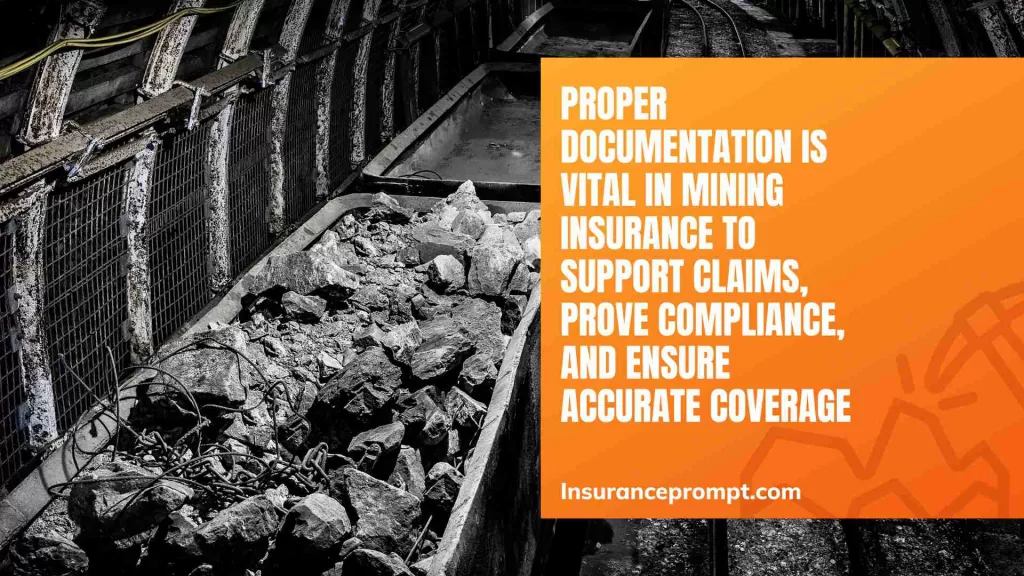
Proper documentation holds immense significance in the mining industry, encompassing various areas such as safety, productivity, and quality management. The following key ideas highlight the importance of proper documentation in mining:
- Efficient task management: Documentation saves valuable time by providing easy access to details, credentials, directions, and other necessary information. It enables seamless task handoffs, avoiding the waste of hours searching for critical information.
- Credibility in project management: Documentation is vital in enhancing credibility. It serves as evidence and aids project managers in effectively executing projects.
- Validation, compliance, and standards: Document control instills confidence by allowing the team to validate facts with accurate documents as proof. It also ensures compliance with regulations and standards, making document management and control essential in the mining industry.
- Enhanced productivity and safety: Electronic document management systems support mining industries by improving productivity, safety, and overall efficiency.
- Risk management and safety protocols: Proper documentation is integral to risk management practices in the mining industry. It involves identifying potential hazards, managing risks, and documenting risk management arrangements within the Safety Management System. Principal mining hazard management plans are a crucial part of the documented Safety Management System, while the general risk management process addresses safety concerns across the entire mine.
In summary, proper documentation is critical in managing risks, controlling costs, and ensuring productivity and safety in the mining industry. Documentation becomes essential to successful mining operations by facilitating efficient task management, enhancing credibility, supporting compliance, and enabling effective risk management.
Insurable values
within the mining industry span a wide range, from high-value machinery to contractual liabilities. It is crucial to address the hazards inherent in mining operations, making safety management a top priority. Risk management is a central element of safety and health management systems (SHMS) in mining.
It involves a cyclical process of identifying high-risk operations or activities, implementing procedural changes to mitigate risks, and monitoring their effectiveness.
Over the past decade, there has been a notable shift in the attitude of mining organizations towards insurance, recognizing it as an indispensable tool for financial protection. The sector has experienced unprecedented losses, with annual property damage and business interruption claims exceeding $5 billion.
The insurance industry has become crucial in managing these risks, with an annual premium base ranging from $500 million to $750 million.
In the mining industry, certain factors significantly influence cost and productivity, such as top-notch equipment, skilled personnel, favorable ore conditions, and a robust safety culture. Proper risk management of these factors becomes imperative.
Proper documentation is essential for effective risk management, cost control, productivity optimization, and safety assurance in the mining industry. It supports the overall management of risks by providing a comprehensive record of processes, decisions, and actions taken to ensure a safe and efficient operation.
Proper maintenance records
play a crucial role in the mining industry, ensuring mining equipment’s productivity and safe operations. The main topics highlight the significance of proper maintenance records:
- Managing mining equipment: Mining operations use movable and fixed assets to conduct business. Maintenance management software can manage mining equipment throughout its entire lifecycle, ensuring optimal performance and safety.
- Criticality of equipment maintenance: Regular maintenance is vital for both productivity and safe operations in the mining industry. By adhering to scheduled maintenance routines, mining machines can be kept in excellent condition, minimizing the risk of failures and accidents.
- Preventive maintenance guidelines: Establishing comprehensive preventive maintenance guidelines, with a scope of at least 85%, can significantly extend the lifespan of mining equipment. This proactive approach reduces downtime and enhances operational efficiency.
- Importance of maintenance records: Construction equipment maintenance records hold great importance within the industry for various reasons. A detailed record of each maintenance issue for every piece of equipment establishes a comprehensive maintenance history, aiding in troubleshooting, identifying patterns, and optimizing future maintenance efforts.
- Regular checks and addressing wear and tear: Inspecting all mining equipment is essential. Timely identification and promptly addressing wear and tear on equipment parts are critical to prolonging the equipment’s lifespan and improving overall productivity.
Proper maintenance records are crucial for managing mining equipment throughout its lifecycle. They ensure safe operations, reduce downtime, and optimize productivity in the mining industry. Mining operations can enhance efficiency and maintain equipment performance by prioritizing maintenance and keeping comprehensive records.
Employee training and safety protocols
Employee training and safety protocols play a vital role in the mining industry, ensuring the safety and well-being of workers. The following main topics highlight the significance of employee training and safety protocols:
- Power of training for accident prevention: Training is a powerful tool in preventing accidents in the mining industry. Providing employees with the necessary information, skills, techniques, and procedures ensures their safety.
- Importance of regular training: Regular training is essential in the mining industry to ensure workers are prepared for emergencies. Emergency evacuation procedures should be included in training programs to enhance response capabilities.
- Threats to mine workers: Various factors threaten mine workers, including accidents and injuries. It is imperative to provide training on necessary safety precautions to mitigate these risks.
- Quality training programs: Developing high-quality training programs is a vital aspect of the Mine Safety and Health Administration’s mission to safeguard miners’ well-being. The mining industry should strive to create comprehensive and effective training initiatives.
- Continuous improvement and safety issues: Employees involved in mining projects must commit to a continuous improvement process. Insufficient training is one of the safety issues facing the mining industry, emphasizing the importance of ongoing training and education.
- Safety challenges and protective measures: The mining industry faces numerous safety issues, including occupational disease risks and the potential for severe injuries or fatalities. Standard practices in mining continually evolve to protect workers’ safety and health. Workers often encounter potentially harmful substances, making adherence to WHMIS guidelines crucial to minimize exposure to dangerous chemicals.
The mining industry can significantly enhance its safety standards by raising awareness, training regularly, and adopting appropriate safety precautions. With a proactive approach to employee training and safety protocols, mining can become a relatively safe industry for its workforce.
Incident reporting and investigation
Incident reporting and investigation play a critical role in the mining industry, ensuring the safety and well-being of workers. Here is the reworded text:
Gathering information and generating reports: Incident reporting and investigation are essential in the mining industry to safeguard the safety and health of workers. Skilled Accident Investigators gather information about accidents to ensure the well-being of employees and create comprehensive written reports.
Sharing information and promoting safety: The Office of the Chief Inspector of Mines regularly publishes mine incident reports, hazard alerts, health and safety notices, and incident information. These publications serve as valuable resources for sharing information and promoting the dissemination of lessons learned.
Responsibility for reporting accidents: The mine site manager reports accidents or incidents, including those occurring during exploration activities conducted on the mine site.
Addressing safety challenges and evolving practices: The mining industry faces various safety issues, ranging from occupational disease risks to the potential for severe injuries or fatalities. Standard practices in mining continually evolve to safeguard the safety and well-being of workers.
Minimizing exposure to harmful substances: Workers in the mining industry often encounter potentially hazardous substances, including polymeric chemicals. Adhering to Workplace Hazardous Materials Information System (WHMIS) guidelines minimizes exposure to dangerous chemicals and protects worker health.
Promoting transparency and accountability: The Mine Safety and Health Administration is vital in promoting transparency and accountability within the mining industry. They publish reports on mining industry accidents, injuries, illnesses, employment, and coal production, contributing to greater transparency and facilitating accountability.
Training for safety precautions: Training workers on necessary safety precautions is essential to prevent accidents and ensure the well-being of mine workers. By providing comprehensive safety training, the risk of injuries can be minimized, creating a safer working environment.
In summary, incident reporting and investigation are integral to the mining industry, prioritizing the safety and health of workers. By promptly reporting incidents, sharing information, following safety guidelines, and providing adequate training, the mining industry can proactively mitigate risks and create a safer work environment.
The world’s leading providers of Subsidence insurance for mines
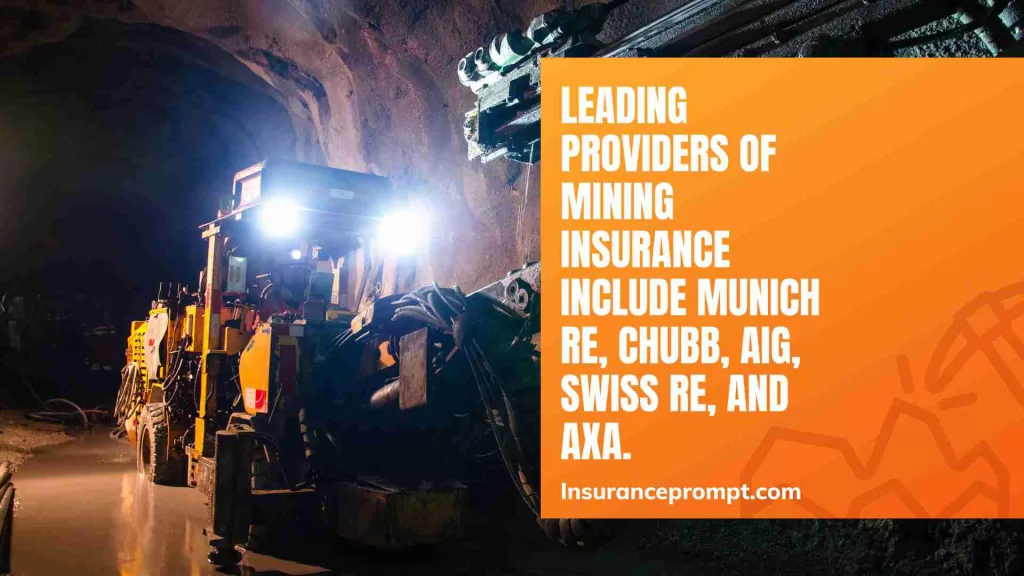
Here are some of the world’s top providers of mining insurance:
- Great American Insurance Group: Great American is the preferred insurer for many leading mining companies, offering tailored coverage options.
- Chubb: Chubb’s expertise enables them to adapt insurance products to meet the evolving needs of the mining industry worldwide. They provide a wide range of mining insurance solutions.
- Gallagher UK: Gallagher UK is a leading broker specializing in mining risks. Their expert team delivers insurance solutions specifically designed for mining companies.
- Expat Financial: With extensive experience, Expat Financial sources international insurance plans for companies and individuals in the global mining industry.
- Trusted Choice: Trusted Choice offers comprehensive mining insurance coverage and advises consulting with an insurance professional to meet all essential coverage needs.
- HFW: HFW provides legal and insurance considerations for the mining sector. They recognize insurance as a vital tool for risk management and corporate governance.
These industry-leading providers cater to the unique insurance requirements of mining companies, offering specialized coverage and expertise in the field.
Is Munich Re one of the world’s leading providers of Mining risk coverage?
Munich Re is recognized as a global leader in mining insurance, specializing in tailored coverage for a range of risks in the industry.
- Bespoke Insurance Cover: Munich Re offers customized insurance solutions specifically designed to address mining risks, encompassing areas such as property damage, business interruption, and assessment of natural catastrophes.
- Tailored Risk Solutions: Munich Re develops individualized risk solutions that cater to client’s unique needs, helping them navigate the challenges prevalent in the mining and mineral processing sector.
- Commitment to Client Interests: Munich Re assists clients with their self-insured interests, providing insurance and risk transfer solutions to ensure comprehensive coverage and protection.
- Expertise in Oil and Gas: With 35 years of market knowledge, Munich Re also offers specialized risk solutions for oil and gas companies, adapting their expertise to address the specific needs of this sector.
- Diverse Industry Presence: Munich Re’s expertise extends across multiple industries, including mining, oil and gas, and captive risk management, leveraging their extensive experience in the insurance field.
Munich Re is a trusted provider, leveraging its industry knowledge and customized approach to meet the insurance needs of mining companies worldwide.
How Bespoke Insurance Covers Mining Risks?
Munich Re specializes in offering customized insurance coverage for mining risks. They create personalized risk solutions to address clients’ specific mining and mineral processing needs, enabling them to overcome their challenges.
Munich Re’s global approach is built upon its expertise in mining underwriting, bolstered by its financial strength and industry knowledge.
They cover many mining activities, including open-pit, underground, and alluvial mining, as well as transportation, equipment, and processing plants, encompassing all commodities.
As one of the world’s top providers of mining insurance, Munich Re offers comprehensive protection for all mining risks, including property damage, business interruption, NatCat assessment, special mining coverages, additional covers, and services.
Munich Re understands the corporate risk exposure associated with the mining industry and delivers tailored solutions to meet the unique requirements of its clients. To accurately assess risks, they have developed a questionnaire that serves as the foundation for individual risk assessment.
Customized Insurance Solutions: How Munich Re Adapts Coverage to Meet Mining Clients’ Needs
Munich Re customizes its insurance solutions for clients by creating tailored risk solutions to address the mining and mineral processing industry’s challenges. They provide personalized insurance coverage for mining risks, such as property damage, business interruption, and natural catastrophes.
Munich Re’s team of mining engineers and experienced underwriters possess specialized skills and practical knowledge of the mining industry, allowing them to comprehend the unique nature of the business and corporate risk exposure.
They are well-versed in the potential risks associated with mining operations, encompassing natural disasters like floods, earthquakes, and storms and human-induced losses such as fire, explosion, collapse, or dam breaches.
Munich Re’s offerings encompass all commodities and mining methods, including open-pit, underground, and alluvial mining, covering transportation, equipment, and processing plants.
Additionally, they provide supplementary coverage and services, recognizing the corporate risk exposure of their clients. Munich Re’s expertise in the insurance industry extends beyond mining to various sectors, including oil and gas, captive risk management, and more.
What are the costs of Mining Liability Insurance from different providers?

Mine subsidence insurance offers financial compensation for losses caused by mine subsidence.
The cost of this insurance varies depending on the state and the desired coverage amount. In Pennsylvania, residential coverage of $150,000 costs just $41.25 annually, with coverage options ranging from $5,000 to $1,000,000. The cost for residential coverage is approximately 27 cents per $1,000 of coverage.
Munich Re, a leading provider of mining insurance, offers customized insurance coverage tailored for the mining industry. However, the cost of their mining insurance needs to be specified in the search results.
Business insurance rates in Kentucky differ based on coverage type, and premiums for mining employees are notably high due to the industry’s elevated risk levels. These rates may increase over time.
USI specializes in providing comprehensive risk management services for mining companies, including legal, loss control, underwriting, environmental, construction, and other aspects of mining insurance.
Nevertheless, the search results do not mention the specific cost of mining insurance from USI.
The cost of workers’ compensation insurance claims in the mining industry (excluding oil and gas) within the OHBWC system is state-dependent and determined based on available data.
What is the cost of mining insurance from Trusted Choice?
Trusted Choice offers comprehensive coverage options to insure mining companies against industry hazards. However, the search results do not mention the specific cost of mining insurance from Trusted Choice.
It is recommended to consult an independent insurance agent who can assist in evaluating coverage needs and finding competitively-priced policies with liability coverage options tailored explicitly for mining businesses. These options can be intricate and require expert guidance to ensure adequate protection.
Mine subsidence insurance, mining insurance, provides financial compensation for losses resulting from mine subsidence.
The cost of this insurance varies depending on the state and the desired coverage amount. For instance, in Pennsylvania, residential coverage of $150,000 costs only $41.25 per year, with coverage available ranging from $5,000 to $1,000,000. Residential coverage expenses amount to approximately 27 cents for every $1,000 of coverage.
Munich Re, renowned as one of the world’s leading providers of mining insurance, offers customized insurance coverage specifically designed for mining risks. However, the exact cost of mining insurance from Munich Re must be specified in the search results.
Which factors determine the cost of mining insurance from US insurance companies
USI’s Mining Practice offers top-notch solutions and services to manage risk exposures related to mining exploration and operations. The mining industry faces unique challenges, including safety concerns, operational liabilities, and rigorous regulatory pressures from state and federal agencies.
USI’s mining professionals deeply understand the risks of surface, underground, and alluvial mining operations. They collaborate directly with mining companies to provide expertise in risk management, legal matters, loss control, underwriting, environmental considerations, construction, surety, and mine reclamation.
However, the search results do not mention the specific cost of mining insurance from USI.
Mine subsidence insurance costs vary based on the state and the desired coverage amount. For instance, in Pennsylvania, residential coverage of $150,000 only costs $41.25 per year, with coverage options ranging from $5,000 to $1,000,000.
Factors influencing the cost of mine subsidence insurance include the property’s location, value, and coverage amount. Residential coverage generally amounts to approximately 27 cents for every $1,000 of coverage.
Data determine the cost of workers’ compensation insurance claims in the mining industry and varies by state. Several factors come into play when calculating the cost of workers’ compensation insurance claims, such as the type and severity of injuries sustained and the number of claims filed.
Comprehensive mining coverage Claim Process
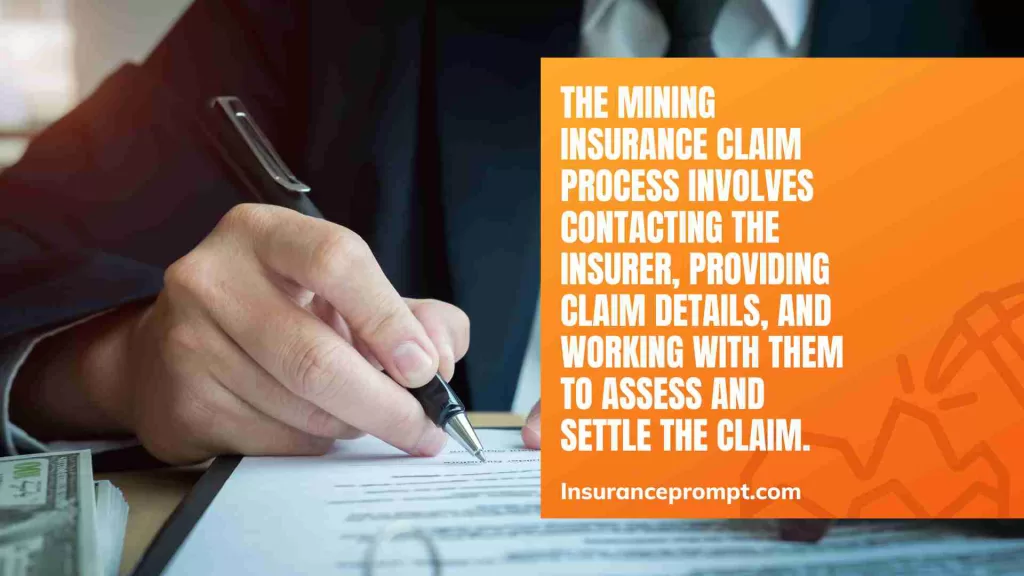
Insurance companies can use process mining to analyze and monitor the entire claim management lifecycle to identify bottlenecks and expedite claim processing.
This approach allows for a comprehensive examination of individual processes, including factors such as time cycle, cost, issues, and reports, providing valuable insights into non-compliant processes. By leveraging process mining, insurance companies can enhance their claim-processing operations.
Celonis Process Mining is an example of a process mining tool that finds applicability within the insurance industry, specifically in claims handling. This tool enables insurers to gain deeper visibility into their processes, improving claim processing efficiency.
Claims settlement represents the ultimate deliverable of an insurance product, and Marsh specializes in providing claims management services tailored for the mining industry. Marsh offers expertise and support throughout the claims handling process to ensure effective claims settlement.
Given the complexity of the mining insurance claim process, seeking guidance from an independent insurance agent is advantageous. These professionals possess the knowledge and experience to assist in assessing coverage needs and providing guidance throughout the claim process.
What are the common reasons for mining insurance claims?
Mining companies encounter unique risks and hazards that necessitate specialized insurance coverage. One of the most significant risks mining companies face is liability lawsuits, and mining business insurance policies offer various liability coverage options.
Global price spikes in commodity costs, attributed to reduced output, have presented coverage challenges within the mining sector. These challenges have prompted discussions about addressing coverage issues associated with the industry.
Captive insurance companies are prevalent in the mining sector due to the specific risks involved, market capacity, and the industry’s distinctive requirements. This approach allows mining companies to have control over their insurance coverage.
Process mining can play a role in identifying fraudulent activities by analyzing claims data and transaction data from policyholders. Suspicious indicators can be detected through process mining techniques, such as unusual actors or steps in the claim process, delays in transaction throughput time, and unsuccessful steps or loops within a process.
The claims settlement represents the ultimate objective of insurance products, and claims management services are readily available for the mining industry. These services ensure the effective handling and resolution of claims for mining companies.
How do mining companies prepare for potential insurance claims?
Mining companies can collaborate directly with insurance companies to identify, mitigate, and manage their risks. These partnerships are often fostered through regular dialogue between mining company executives and insurers and on-site visits to mining sites and processing facilities.
These interactions help establish strong and enduring relationships between mining companies and insurers.
Furthermore, mining companies can also engage the services of independent insurance agents to assess their specific coverage needs and seek out competitively-priced policies that align with those requirements. Independent agents possess the expertise to guide mining companies in finding suitable insurance solutions.
Additionally, captive insurance companies are commonly adopted within the mining sector due to the unique risks involved, the capacity of the market, and the distinct needs of mining companies. Opting for captive insurance allows mining companies more control over their insurance coverage.
USI’s Mining Practice offers tailored services and solutions, such as crisis management coverage, business interruption valuation/extra expense, and compliance review with mine safety and health administration standards.
Although the search results might provide a partial list of how mining companies prepare for potential insurance claims, it is evident that mining companies can collaborate with insurance companies and independent insurance agents to assess their risks, determine appropriate coverage needs, and find suitable insurance solutions.
What procedures must be followed while making a mining insurance claim?
The process of filing a mining insurance claim can vary depending on the insurance company and the type of coverage. Generally, when a mining company needs to file a claim, it is advisable to contact their insurance company or agent and have essential details ready.
These details may include the mining company’s full name, policy number, and comprehensive information about the claim.
Marsh offers claims management services specifically designed for the mining industry. These services assist mining companies in navigating the complex claims process, ensuring they receive the appropriate compensation for their losses.
Furthermore, mining companies can collaborate with independent insurance agents to assess their unique coverage needs and discover competitively-priced insurance policies that align with those requirements. Independent agents possess the expertise to guide mining companies in finding suitable coverage options.
Although the search results might present a partial list of the specific steps involved in filing a mining insurance claim, it is evident that mining companies should initiate contact with their insurance company or agent and be prepared to provide comprehensive details regarding the claim.
What information should be included in a mining insurance claim?
The information required for a mining insurance claim can vary depending on the insurance company and the type of coverage. When filing a claim, mining companies should contact their insurance company or agent and be ready to provide relevant details, including their full name, policy number, and comprehensive information about the claim.
Marsh offers claims management services tailored specifically for the mining industry. These services are designed to assist mining companies in navigating the complex claims process, ensuring they receive the appropriate compensation for their losses.
Insurance companies determine their premiums by assessing risks and representing the likelihood of potential client claims. Process mining can optimize insurance processes, enhancing customer experience, compliance, and control, while reducing operational costs.
Mining companies should contact their insurance company or agent and be prepared to furnish details regarding the claim.
Conclusion
Mining insurance holds immense significance in managing risks for mining operators. As previously mentioned, mining operations entail risks that can result in substantial financial setbacks if adequate coverage is lacking. Hence, mining operators must prioritize obtaining appropriate insurance to safeguard their operations and employees.
As highlighted, mining practices must also evolve to contribute to community development and environmental protection.
Mining insurance can contribute to this objective by promoting responsible practices and effective risk management.
In summary, mining insurance serves as an indispensable element for risk-free operations in the mining industry, and mining operators should proactively secure suitable coverage to ensure their operations are adequately protected.
Frequently Asked Questions
What is Meant by Mining Insurance?
Mining insurance is a specialized insurance offering designed to protect mining companies from the various risks and hazards associated with the industry. It provides a range of unique coverage options tailored to the specific needs of mining operations.
Does the mining industry entail a high level of risk?
Indeed, the mining industry is characterized by a significant risk due to the nature of its operations, which encompass working in hazardous environments, operating heavy machinery, and handling potentially harmful substances.
What risks do mining companies encounter?
Mining companies face various risks, including liability lawsuits, natural disasters, machinery breakdowns, environmental and transportation hazards, and financial risks.
What insurance solutions are available for the mining sector?
The mining sector has a wide array of insurance solutions, encompassing property damage and business interruption insurance, D&O insurance, construction insurance, and subsidence insurance for coal mines.
What challenges does mining insurance face?
Mining insurance encounters challenges such as accurately valuing high-value machinery, addressing liability arising from contractual agreements, managing insurance complexity, and navigating the intricate process of transporting mined products to the market.
What unique coverage options does mining insurance offer?
Mining insurance provides distinct coverage options tailored to the industry, including liability coverage, property damage, business interruption, and D&O insurance.
Why is it beneficial to consult an independent insurance agent when evaluating coverage needs?
Given the potential complexity of mining insurance, it is advantageous to engage an independent insurance agent who can assist in assessing coverage requirements and finding competitively-priced policies that meet those needs.
References
Management Liability Insurance – City Rural Insurance Brokers Adelaide. https://cityrural.au/management-liability-insurance/
Business Income Archives – Mackoul Risk Solutions – Condominium Co-op Insurance – New York and New Jersey. https://mackoul.com/blog/tag/business-income/
9 Best Loveland Renter’s Insurance Companies | Expertise.com. https://www.expertise.com/co/loveland/renters-insurance
Georgia Federal Disability Retirement Lawyer | The Vaughn Law Firm, LLC. https://thevaughnlawfirm.com/federal-disability-retirement/
SONJA YANNIS MICHAELA KAFETZAKIS | Full insurance, No Excess. https://carrentalcrete.gr/en/full-insurance-no-excess/
Determining What Coverage You Need For Your Boat – Choosing The Best Insurance Plan For You. http://geraldrojek.com/2021/02/18/determining-what-coverage-you-need-for-your-boat/
Mine Subsidence Insurance | Bankrate. https://www.bankrate.com/insurance/homeowners-insurance/mine-subsidence-insurance/
Beth & Cory’s Mom: There’s Damage We Couldn’t See. https://www.alwaysbcmom.com/2008/02/theres-damage-we-couldnt-see.html
General Liability vs. Product Liability Insurance. https://www.dixonblackwood.com/blog/general-liability-vs-product-liability-insurance.aspx
Mining Insurance Policies – Are You Covered? – Conway. https://www.conwayes.com/mining-insurance-policies/
Journalizing and Posting – BVR & ASSOCIATES. https://www.bvr-cpaconsultants.com/articles/journalizing-and-posting
mining machinery project. https://www.allaghet.it/12/23-16520.html
CLXT250 – CLXT Quality Assurance – NAIT. https://www.nait.ca/nait/continuing-education/courses/clxt250-clxt-quality-assurance
3M™ Disposable Protective Coverall 4530 | 3M Puerto Rico. https://www.3m.com.pr/3M/en_PR/p/d/b00046825/
https://ferien-martin.de/05_18-41994.html
What are the steps involved in filing a personal injury lawsuit? | Cromartie Law. https://www.hlcromartielaw.com/blog/2021/06/what-are-the-steps-involved-in-filing-a-personal-injury-lawsuit/
Business Insurance in Michigan: Importance of Protecting Online Data – Allied Insurance Managers, Inc: Allied Insurance Managers, Inc. https://aimmigration22.flywheelsites.com/business-insurance-in-michigan-importance-of-protecting-online-data/
- Does M&S Do Car Insurance? A Full Guide In 2024 - April 15, 2024
- Pet Insurance for Older Dogs: 2024 Full Guide & Top Providers - March 17, 2024
- Small Business Equipment Breakdown Insurance: Full Coverage - November 6, 2023

